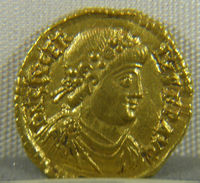Glycerius
| Flavius Glycerius | |
|---|---|
| Emperor of the Western Roman Empire |
|
 |
|
| Reign | c. March 3, 473 – June 474 |
| Born | c. 420 |
| Died | After 480 (aged 60) |
| Predecessor | Olybrius |
| Successor | Julius Nepos |
Glycerius[1] (c. 420 – after 480) was Western Roman Emperor from 473 to 474. He later served as a bishop in the early Catholic Church.
Contents |
Rise to power
Sources on Glycerius are scarce and scanty. It is known that, at the time of his elevation to the throne, he was a comes domesticorum, the commander of the imperial guard; as regards his previous career, he had been the military commander in Dalmatia.[2]
In 472, the Western Roman Empire was plagued by a civil war, fought between Emperor Anthemius and his Magister militum (commander in chief of the army), Ricimer. Ricimer killed the Emperor and put Olybrius on the throne, but in a short time both Ricimer and Olybrius died. The Eastern Roman Emperor, Leo I the Thracian, tarried in choosing his successor, so the Germanic elements of the army, represented by the new Magister militum Gundobad (a nephew of Ricimer's), elected Glycerius Emperor on March 3 or 5 473 in Ravenna.
Rule
Little is known about the short reign of Glycerius, but it appears that he tried to reconcile with the Eastern Roman Empire and that he succeeded in keeping his own Empire under control despite the attacks of the barbarian peoples. For most of his rule, Glycerius lived in Northern Italy, as testified by the fact that the only mints which issued in his name are Milan and Ravenna.
Gothic menaces
In 473, the King of the Visigoths, Euric, ordered the invasion of Italy, but his commander Vincentius was defeated and killed by Glycerius' comites Alla and Sindila. Despite the victorious defence of Italy, Glycerius could do nothing to prevent the Visigoths from conquering Arelate and Marseille, in Gaul.
At the same time, the Ostrogoths led by King Widimir began marching to Italy. The possibility that the two Gothic armies would merge was disastrous, and Glycerius sent an envoy to Widimir to tell him that the territories he wanted were already occupied by the Visigoths and to suggest that he move to Gaul. If this strategy barred Vincentius from receiving reinforcements, it caused the convergence of both Gothic armies against Gaul.
Relationship with the Eastern Roman Empire
The Eastern Roman Emperor Leo I did not recognise Glycerius, as his election had not been ratified by the Eastern court, and it was suspected that he was a puppet of Gundobad. Therefore Leo chose a candidate on his own, Julius Nepos, Magister militum in Dalmatia related to the Eastern Empress Verina. Because his election came very late, however, Julius Nepos could not leave, as the ports were closed for the winter. In the mean-time, Leo I died in January 474 and was succeeded by his nephew, the young Leo II, who chose his own father Zeno as co-emperor after a short time.
Glycerius tried to re-conciliate with the Eastern court or, at least, to cause as few conflicts as possible with it. For example, he did not choose a second Consul in order to allow Leo II to be Consul alone for the year 474. Glycerius also tried to obtain the support of the Church, issuing a law against simony (March 11, 473), which was welcomed by the ecclesiastic hierarchy.
Deposition and death
In spring 474, the ports were re-opened and Julius Nepos, the pretender to the Western throne, crossed the Adriatic sea and arrived in Italy to depose Glycerius. It is probable that Glycerius left Ravenna for Rome, probably to resist the invader; the clue is a silver coin minted in Rome, in which Glycerius claims to be Emperor together with other two Emperors (Leo II and Zeno), thus not recognising Julius Nepos. However, Julius Nepos disembarked at Ostia in July 474 and deposed Glycerius without a fight. Glycerius was sent to Dalmatia as Bishop of Salona.
Glycerius' deposition was thus without any bloodshed, and historians investigated the possible reasons why the Western Emperor, who had Gundobad and his army at his command did not try to resist. One possible reason is that Glycerius' elevation, not recognised by Eastern court, received the support of neither the Roman senate nor the Gallic-Roman aristocracy; resisting Nepos without the support of the Senate would have been a bad choice for Gundobad.[3] It is possible that Gundobad, who was absent from Italy when Glycerius was deposed, had gone to Gaul to gather some more troops or to receive the legacy of his father Gundioc, thus effectively leaving Glycerius alone.
Glycerius probably died at Salona, which in 475 had been reached by Julius Nepos, who had been deposed in turn by the Magister militum Orestes; he was still in Salona when, in 476, the last Western Roman Emperor, Romulus Augustus, was deposed by Odoacer, King of the Heruli. The historian Malchus maintains that in 480 Glycerius was a member of the conspiracy that led to Julius Nepos' death and thus favoured Odoacer; however, the news of Glycerius' appointment to the prestigious rank of Bishop of Milan, which would support the theory of the collaboration between Glycerius and Odoacer, is usually considered a rumor.
Notes
- ↑ Prosopography of the Later Roman Empire II.514
- ↑ Meijer, Fik, Emperors Don't Die in Bed, Routledge, 2004, ISBN 0-415-31201-9, p. 159.
- ↑ O'Flynn, John Michael, Generalissimos of the Western Roman Empire, University of Alberta, 1983, ISBN 0-88864-031-5, p. 130.
Bibliography
- Mathisen, Ralph W., "Glycerius (3/5 March 473 – June 474)", De Imperatoribus Romanis
External links
|
|||||||||||||||||||||||